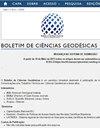巴西领土SRTM数据处理的垂直精度评估
IF 0.5
Q3 Earth and Planetary Sciences
引用次数: 8
摘要
本研究旨在确定从航天飞机雷达地形任务(SRTM)数据处理中获得的干涉数字高程模型(DEM)的垂直精度。研究比较了SRTM-GL1 (Shuttle Radar Topographic Mission-Global 1) 30米分辨率模型和以下90米分辨率模型:(a) EMBRAPA;(b)美国地质调查局提供的基于多比例尺穿梭高程导数的水文数据和地图(水系);(c)国际农业研究协商小组-空间信息联合会;(d)乔纳森·德·费兰蒂。精度分析考虑了巴西不同地区,采用了来自全球导航卫星系统(GNSS)跟踪器或地形方法的1,087个现场点。在90米分辨率模型中,Jonathan de Ferranti模型的RMSE为9.61m,精度最高。大部分1:10万比例尺的SRTM模型达到制图精度标准A级。然而,在1:5万尺度下的精度没有达到相同的性能。SRTM误差与坡度呈线性相关,误差最显著的地区往往是森林地区。30米分辨率SRTM的精度(RMSE为8.52m)比Jonathan de Ferranti的90米分辨率模型(RMSE为9.61m)提高了约10%。本文章由计算机程序翻译,如有差异,请以英文原文为准。
VERTICAL ACCURACY ASSESSMENT OF THE PROCESSED SRTM DATA FOR THE BRAZILIAN TERRITORY
This research aims to determine the vertical accuracy of the Interferometric Digital Elevation Model (DEM) obtained from the processed Shuttle Radar Topographic Mission (SRTM) data. The research compared the SRTM-GL1 (Shuttle Radar Topographic Mission-Global 1) with 30-meter resolution and the following 90-meter resolution models: (a) EMBRAPA; (b) Hydrological data and maps based on Shuttle Elevation Derivatives at multiple Scales (HydroSHEDS) (HydroSHEDS), provided by the United States Geological Survey (USGS); (c) Consultative Group for International Agricultural Research-Consortium for Spatial Information (CGIAR-CSI); and (d) Jonathan de Ferranti. The accuracy analysis considered the diverse Brazilian regions, adopting 1,087 field points from the Global Navigation Satellite System (GNSS) trackers or topography methods. The Jonathan de Ferranti model achieved the best accuracy with RMSE of 9.61m among the 90-meter resolution models. Most SRTM models at 1:100,000 scale reached Grade A of the Cartographic Accuracy Standard. However, the accuracy at the 1: 50,000 scale did not achieve the same performance. SRTM errors are linearly related to slope and the most significant errors always occur in forest areas. The 30-meter resolution SRTM showed an accuracy of around 10% better (RMSE of 8.52m) than the model of Jonathan de Ferranti with 90-meter resolution (RMSE of 9.61m).
求助全文
通过发布文献求助,成功后即可免费获取论文全文。
去求助
来源期刊

Boletim De Ciencias Geodesicas
Earth and Planetary Sciences-General Earth and Planetary Sciences
CiteScore
1.70
自引率
20.00%
发文量
10
审稿时长
3 months
期刊介绍:
The Boletim de Ciências Geodésicas publishes original papers in the area of Geodetic Sciences and correlated ones (Geodesy, Photogrammetry and Remote Sensing, Cartography and Geographic Information Systems).
Submitted articles must be unpublished, and should not be under consideration for publication in any other journal. Previous publication of the paper in conference proceedings would not violate the originality requirements. Articles must be written preferably in English language.
 求助内容:
求助内容: 应助结果提醒方式:
应助结果提醒方式:


